List of macOS Versions in Order & History
Apple’s macOS (also known as Mac OS X or simply OS X) operating system as we know it today has more than 20 years of innovation behind it. Development began in 2000 as a project to replace the legacy Mac OS software and integrate NEXTSTEP, a Unix-like operating system developed under Steve Jobs’s NeXT, Inc. in the late 1990s.
Over time, Apple has introduced a wide range of features that set macOS apart from Windows and Linux operating systems. Today, all Mac devices, including iMac, iMac Pro, MacBook Pro, MacBook Air, and Mac Mini, come with the latest version of macOS pre-installed.
History of macOS versions in order
In this definition...
Public beta: Kodiak

Release date: September 13, 2000
Cost: $29.95 USD
Kodiak is the internal code name Apple gave to its Mac OS X public beta. It was the first instance of Apple’s Aqua, a GUI and visual theme that offered a new font set, app icons, and other features. The public beta also introduced the Dock and menu bar, which created a unique navigation experience. As is the case with many public beta versions of software, it was meant to find various bugs and flaws before the operating system’s final release. The public beta included a suite of native apps that can still be found in the operating system today:
- TextEdit
- Preview
- Terminal
- QuickTime media player
Version 10.0: Cheetah

Release date: March 24, 2001
Cost: $129 USD (single license)
Cheetah is the internal code name Apple gave to the first official release of Mac OS X version 10.0. Rather than introducing many new features, this version addressed the criticisms and flaws found in the public beta. However, many users felt it still had room for improvement with its responsiveness, reliability, and variety of applications it offered.
Version 10.1: Puma

Release date: September 25, 2001
Cost: $129 USD (single license; free for Version 10.0 users)
Mac OS X version 10.1, internally named Puma, was offered to version 10.0 users as a free upgrade because many critics felt Cheetah was not ready for public release. In addition to system-wide performance improvements, Apple introduced a few new features:
- DVD playback support
- Easier CD and DVD burning in Finder app
- Wider printer compatibility
Version 10.2: Jaguar

Release date: August 23, 2002
Cost: $129 USD (single license)
Version 10.2 was the first Mac OS X version to use its internal code name, Jaguar, as part of its marketing strategy. Jaguar was a paid upgrade for all Mac OS X users, though Apple offered free upgrades for K–12 teachers in the United States. New features in the Jaguar release included:
- Graphics compositing directly on the video card with Quartz Extreme
- Contact storage with Address Book
- Network sharing capabilities with Rendezvous (later named Bonjour)
- AOL-based instant messaging with iChat
- Search functionality in Finder
- Accessibility tools with Universal Access
- MPEG-4 support for QuickTime
Version 10.3: Panther

Release date: October 24, 2003
Cost: $129 USD (single license)
Version 10.3, called Panther, was the first version to discontinue support for some of Apple’s oldest hardware models—namely the Power Macintosh and PowerBook. Panther included the following improvements and new features:
- Safari web browser
- Fast user switching
- FileVault encryption
- Font Book
- Better interoperability with Microsoft Windows and support for Microsoft Office files
- Video conferencing capabilities in iChat
- Better multi-window navigation with Exposé
- Built-in fax support
- Faster PDF rendering with Preview
Version 10.4: Tiger

Release date: April 29, 2005
Cost: $129 USD (single license)
Tiger was the longest-running version of Mac OS X, with 30 months between its launch and the launch of its successor. It was the first version of Mac OS X that was native to Macs made with Intel processors. Tiger included the following improvements and new features:
- Spotlight search
- Voice control with VoiceOver
- A scripting tool called Automator
- RSS reader in Safari
- Smart Mailboxes in Mail
- Mini applications layer based on HTML, CSS, and JavaScript called Dashboard
- 64-bit architecture
- Dictionary and thesaurus
- A mathematical program called Grapher
Version 10.5: Leopard
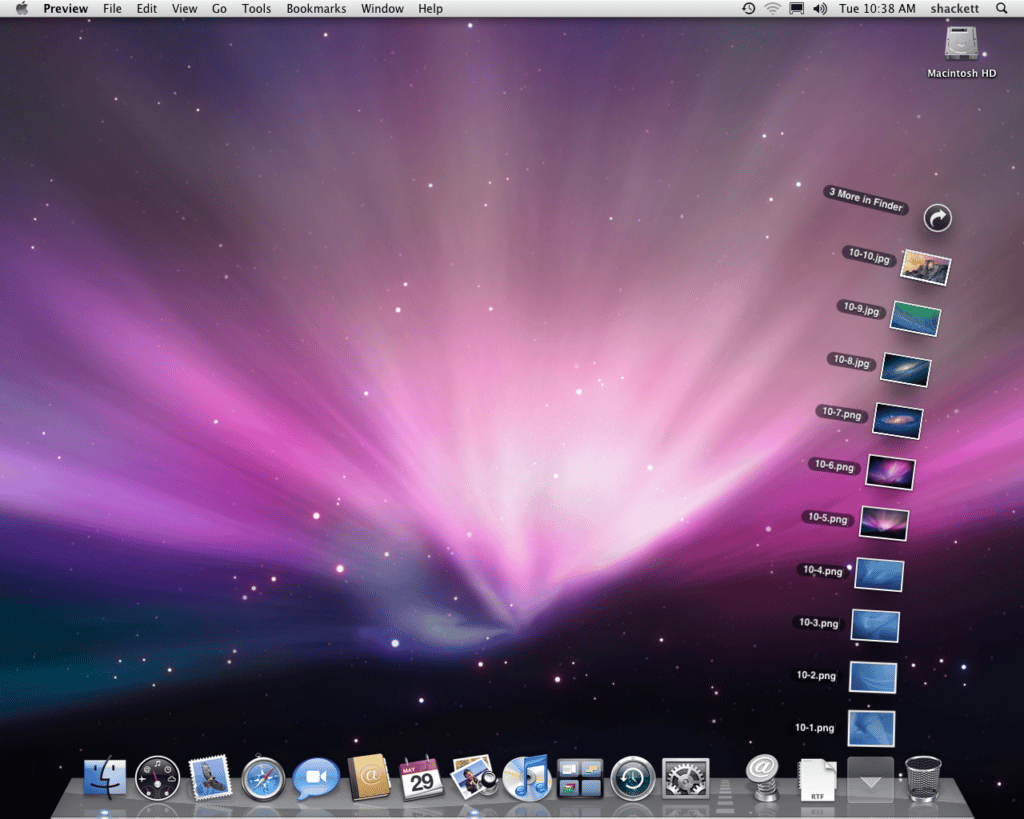
Release date: October 26, 2007
Cost: $129 USD for desktop (single license)
Apple’s release of Leopard was significantly delayed because of the concurrent development and launch of the iPhone. Leopard was thought to bring some of the most significant changes to the Mac OS X environment, and it included the following improvements and new features:
- Remote access for MobileMe users with Back to My Mac
- Redesigned menu bar and Dock with a new organization feature called Stacks
- Parental Controls
- Calendar sharing and group scheduling with iCal
- Green screen support and live filters with Photo Booth
- Advanced file preview framework called Quick Look
- Virtual desktop capability called Spaces
- Automated backup with Time Machine (required separate hardware)
Version 10.6: Snow Leopard
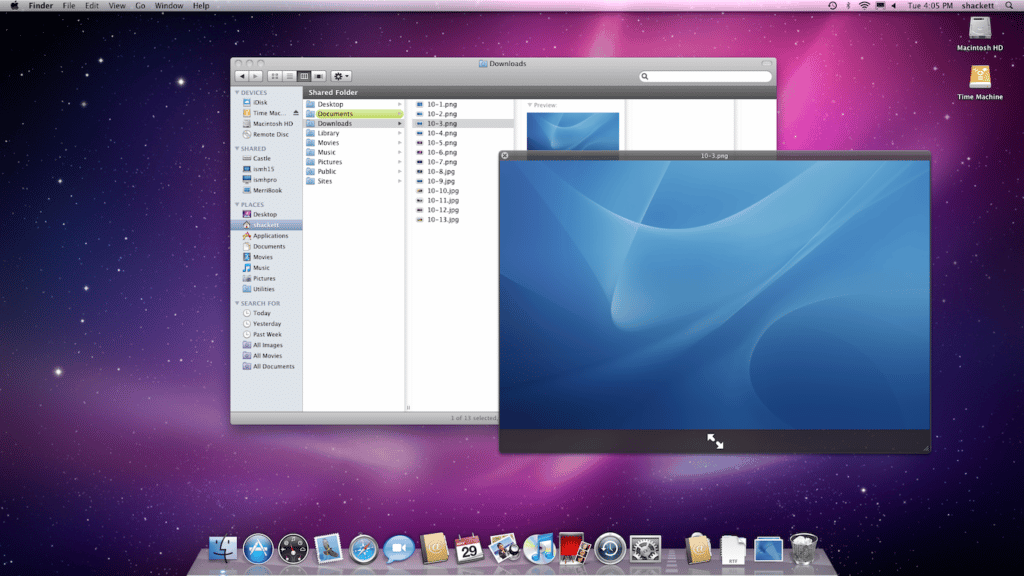
Release date: August 28, 2009
Cost: $29 USD (single license)
Snow Leopard was the last version of Mac OS X that was released in disc form and at a significantly lower price point. This version focused heavily on expanding the Mac OS X 64-bit architecture and improving performance, efficiency, and stability. As such, there were minimal updates to the “look and feel” of the OS, but noticeable improvements to the amount of disk space available (about 7GB) and system-wide responsiveness. New features and improvements introduced in Snow Leopard include:
- Mac App Store for digital app/OS installation aligned with the iOS App Store
- Finder and QuickTime X rewritten in Cocoa, Apple’s object-oriented API
- Crash resistance in Safari
- Multi-touch trackpad support
Version 10.7: Lion
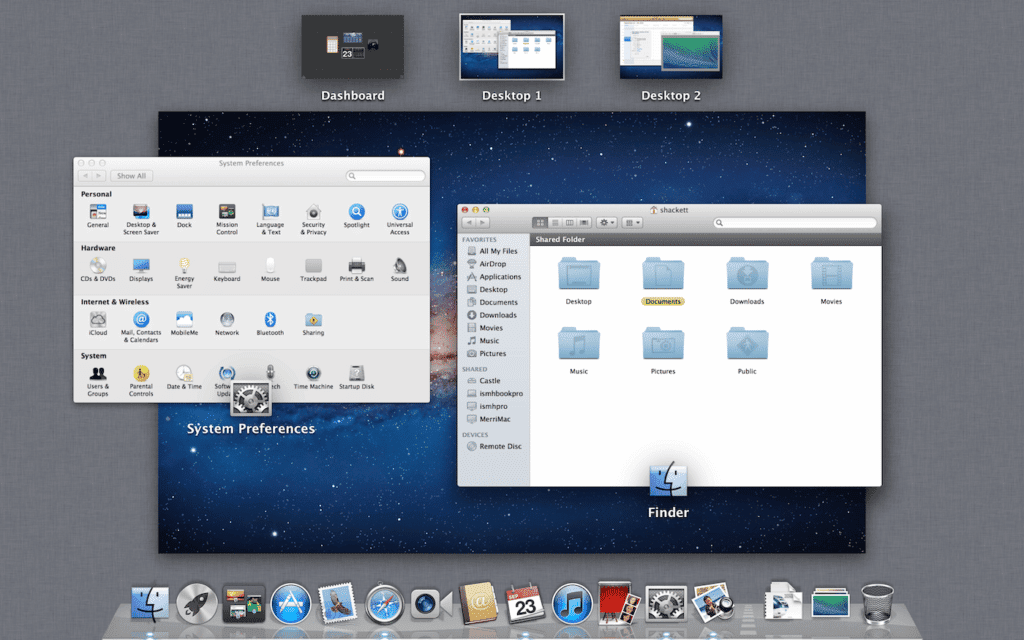
Release date: July 11, 2011
Cost: $29.99 USD
Lion was the first version of Mac OS X to be released in the Mac App Store. This proved to be prohibitive for users who had not upgraded to Snow Leopard, so Apple began offering Lion upgrades via in-store downloads or USB flash drive installations. Lion was also the first release that was not priced for individual licenses—instead, users could purchase the upgrade once and download it to all of their supported Mac devices. Lion included the following new features and updates:
- Peer-to-peer wireless sharing with AirDrop
- Video conferencing with FaceTime
- Apple Push Notification System (APNS)
- Emoji support
- Launchpad
- Multi-touch gestures
- Mission Control
- System-wide support for full screen apps
- Resume functionality, which restarts apps in their most recent state
- “Natural” scrolling which mimics touchscreen scrolling behavior
Version 10.8: Mountain Lion

Release date: July 25, 2012
Cost: $19.99 USD
Mountain Lion marked Apple’s shift toward an annual update release cycle. Its primary goal was to incorporate more apps and behaviors found in iOS to create a cohesive user experience across all Apple devices. These apps and behaviors include:
- Cross-device synchronization with iCloud
- Messages app
- Reminders app
- Notes app
- Notification Center
- Game Center app
- Device mirroring with AirPlay
- System-wide sharing
- Embedded Facebook and Twitter integration
- Dictation
Version 10.9: Mavericks

Release date: October 22, 2013
Cost: Free
Mavericks was the first update to OS X—dropping “Mac” from the official title—offered completely free of charge. It was also the first release that departed from the “big cat” naming convention in favor of a new theme centered around California landmarks. Mavericks included the following feature updates and additions:
- iBooks
- Maps
- Password storage with iCloud Keychain
- Better multi-display support
- Interactive notifications
- Finder tabs and tags for better file organization and navigation
- Improved battery life and reduced energy consumption
- Compressed memory to improve responsiveness
Version 10.10: Yosemite

Release date: October 16, 2014
Cost: Free
Yosemite expanded the Continuity features introduced in Mountain Lion and Mavericks to create a fluid hand-off experience between Mac and iOS devices. Yosemite feature updates and additions include:
- Today view in Notification Center
- iCloud Drive cloud storage
- Safari update optimized for streaming
- Mail update with support for in-app PDF editing
- Messages update with more fine-grained controls
- Family Sharing
- iTunes 12
- Swift programming language for app developers
Version 10.11: El Capitan

Release date: September 30, 2015
Cost: Free
Because Yosemite brought many function and design updates to OS X, El Capitan was more focused on refinement. Apple’s developers wanted to make the operating system faster and more responsive while also offering more intuitive UX capabilities. Feature updates and additions in El Capitan include:
- Split screen window management
- Streamlined, gesture-driven Mission Control functionality
- Advanced Spotlight features for stocks, weather, sports, and natural language processing
- Pinned sites in Safari
- Smart Suggestions in Mail
- Improved graphics performance with Metal
Version 10.12: Sierra

Release date: September 20, 2016
Cost: Free
Sierra was the first update to use the “macOS” moniker that’s still in place today. This was meant to bring consistency to all of the operating systems in the Apple family, including iOS, watchOS, and tvOS. Sierra introduced a number of new features and improvements that continued to streamline the user experience across all of these devices. These include:
- Siri, Apple’s virtual assistant
- Universal Clipboard for copying and pasting from one device to another
- iCloud Desktop and Documents
- Auto Unlock with Apple Watch
- Apple Pay
- Tapback reactions in Messages
- Picture in picture support
- Optimized Storage
- Apple Music support in iTunes
Version 10.13: High Sierra
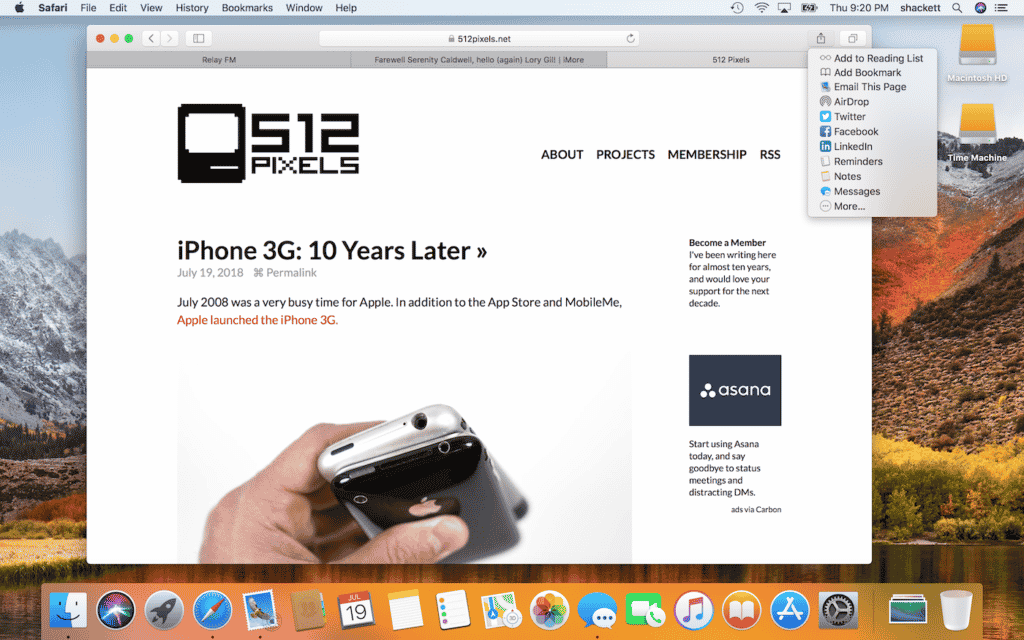
Release date: September 25, 2017
Cost: Free
Similar to Snow Leopard, Mountain Lion, and El Capitan, High Sierra brought mostly under-the-hood updates to macOS. Specifically, High Sierra introduced the following feature updates and additions:
- Apple File System (APFS) for improved storage performance, security, and reliability
- Metal 2, an updated graphics API, with support for virtual reality, machine learning, natural language processing, and external GPUs
- Support for High-Efficiency Video Coding (HEVC)
- Relatively minor performance and design updates to Photos, Mail, Messages, Safari, Notes, and Siri
Version 10.14: Mojave
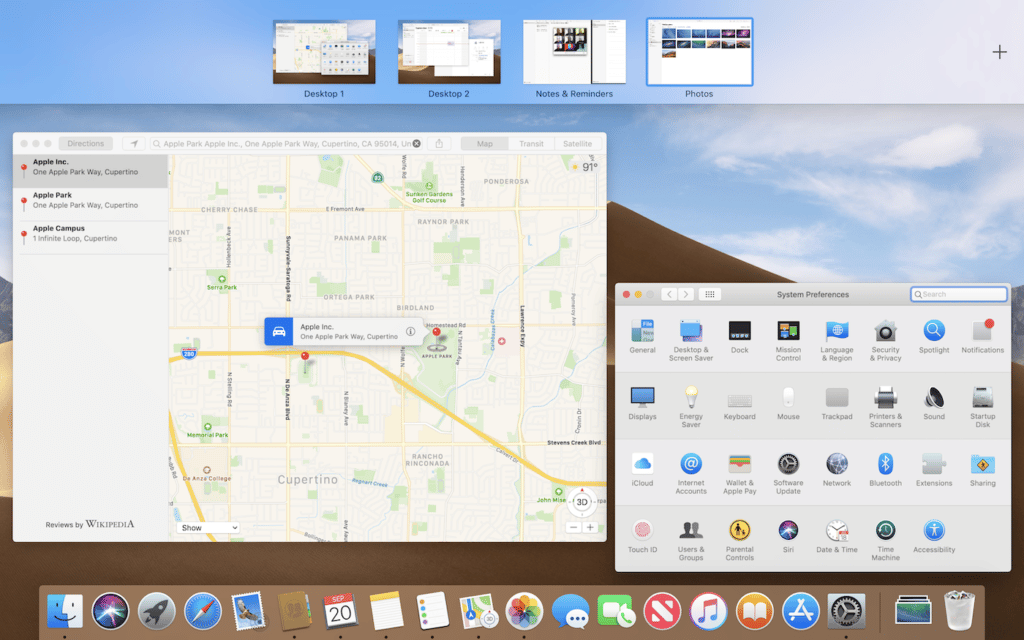
Release date: September 24, 2018
Cost: Free
Mojave introduced several design and productivity updates that elevated the macOS user experience. New and improved features include:
- Dark Mode
- Customizable file sorting for desktop with Stacks
- Screenshot and screen recording capabilities
- iOS apps, including News, Stocks, Voice Memos, and Home
- Redesigned Mac App Store
- Intelligent Tracking Prevention for safer internet browsing with Safari
Version 10.15: Catalina

Release date: October 7, 2019
Cost: Free
macOS Catalina introduced new features and enhancements that focused on entertainment and iPad integration. Specifically, these innovations included:
- Apple Arcade for desktop gaming
- Apple Music
- Apple Podcasts
- Apple TV
- Sidecar functionality for extending Mac workspace to iPad
- Voice Control for added accessibility
- Mac Catalyst for bridging the gap between Mac and iPad apps
- Screen Time activity monitoring
- Find My app
- Relatively minor updates to Safari, Mail, Notes, Photos, and Reminders
Version 11: Big Sur

Release date: November 12, 2020
Cost: Free
In terms of version numbering, macOS Big Sur marked a shift away from the 10.x convention in favor of a whole number increment. Big Sur also introduced a major refresh of the macOS user interface, with easier navigation controls, a new color palette, and completely redesigned app icons that are consistent across Apple devices. Other feature improvements and additions include:
- Control Center
- Do Not Disturb
- Updated Notification Center and widgets
- Safari updates for faster performance, better privacy, improved productivity, and longer battery life
- Support for Apple M1 chip
- File level encryption
Version 12: Monterey
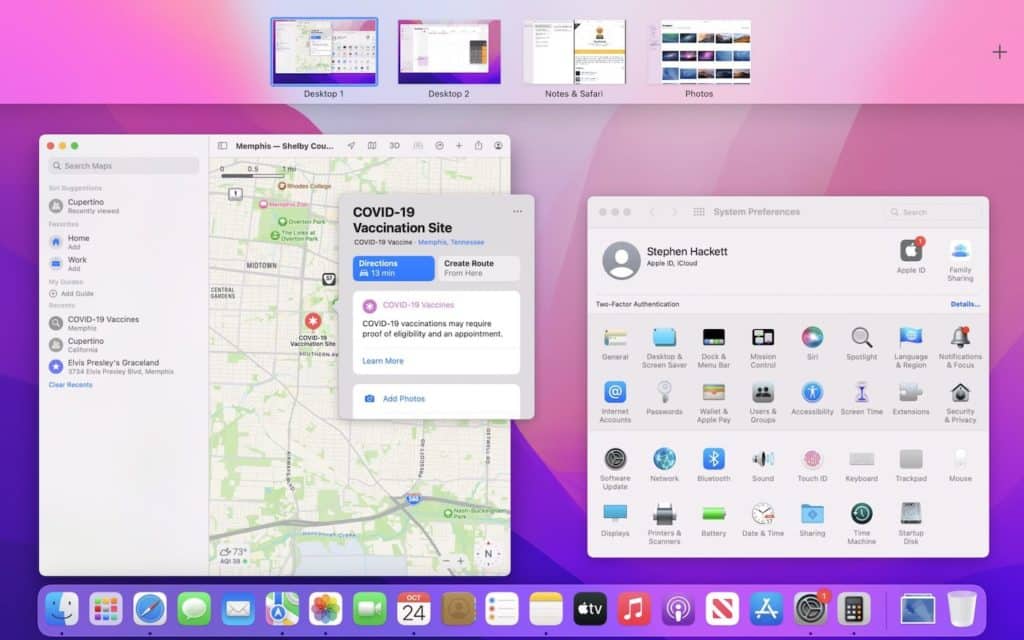
Release date: October 25, 2021
Cost: Free
Monterey introduced a wide range of new features and functionalities that improve the macOS user experience. These include:
- Activity automation with Shortcuts
- TestFlight for Mac
- Universal Control for seamless UX between Mac and iPad devices
- Spatial audio and Portrait mode for FaceTime
- Share Play for FaceTime, Apple Music, Apple TV+, and third-party apps
- On-device machine learning with Live Text and Visual Lookup
- Customizable Focus modes
- Note sharing and real-time collaboration
- Tab grouping in Safari
- Low Power Mode for battery conservation